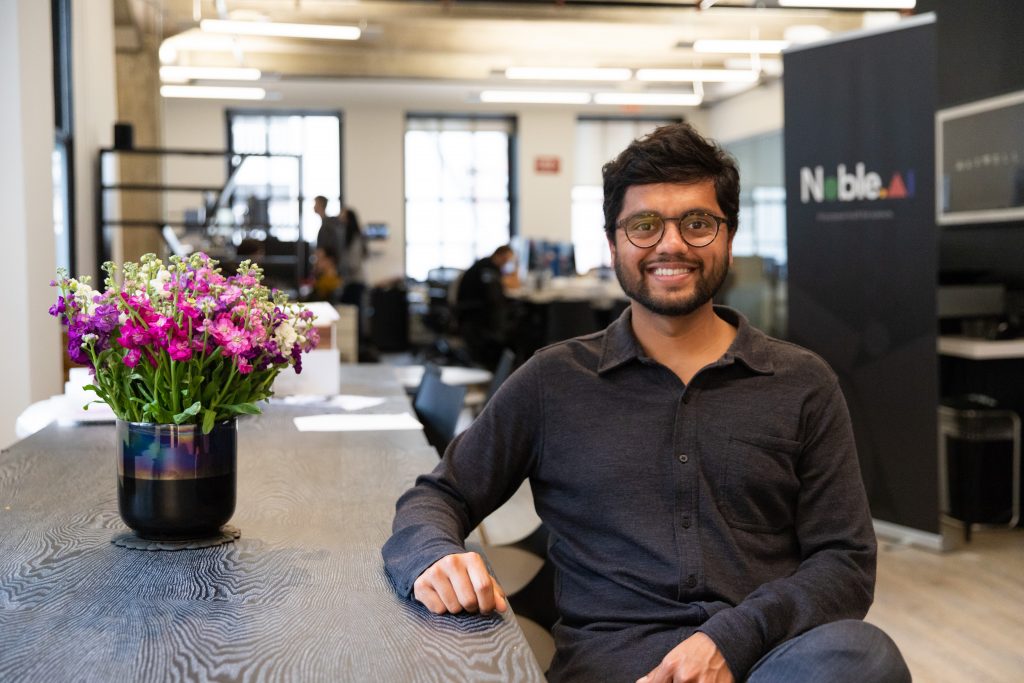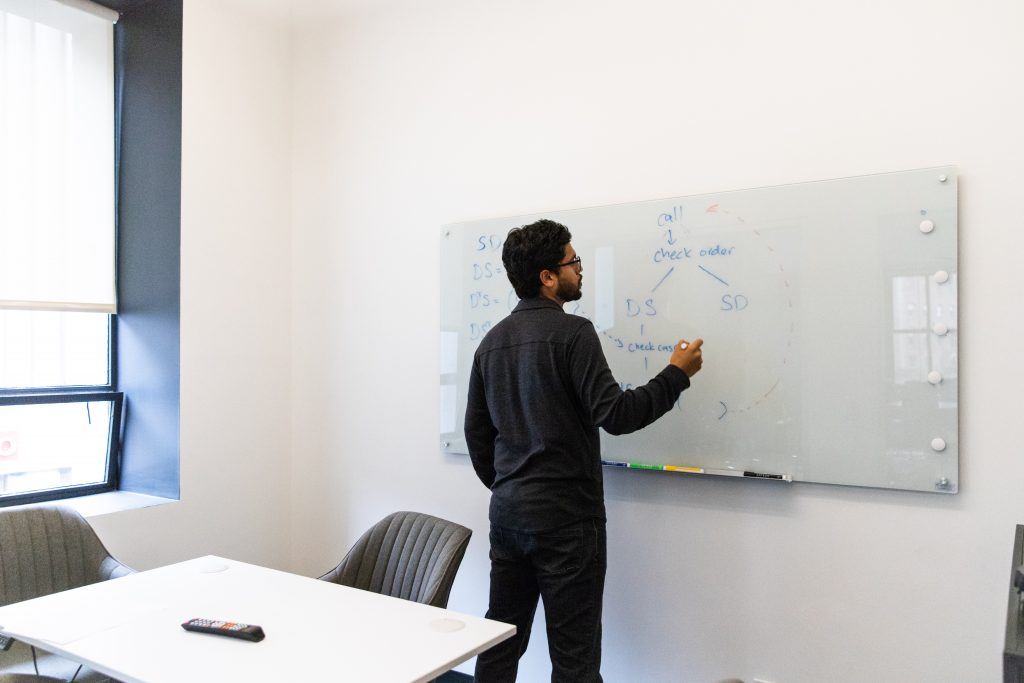Working AI: At the Office with Research Scientist Archis Joglekar

Title: Research Scientist
Location: San Francisco, CA
Age: 31
Education: Ph.D. in Plasma Physics (from the Nuclear Engineering department)
Years in industry: 1 year
Google, Facebook, and Amazon aren’t the only places to work on cutting-edge AI products. Archis went from studying fusion physics to building AI models at Noble.ai to help other scientists speed up their R&D. Learn what his job entails, how his academic background translates to his current work, and what it’s like to work at an AI startup.
How did you get started in AI?
I realized very early in my scientific career that I enjoy working with new technologies to solve scientific problems. During my postdoctoral work at UCLA, it became obvious that artificial intelligence, and deep learning in particular, were forming a new frontier of scientific computing. Curiosity did the rest!
You completed an undergraduate degree and a PhD in Nuclear Engineering before you started working on machine learning in industry. What was that transition like?
My PhD and postdoctoral work prepared me to transition into this field as well as I could have hoped. From a technical perspective, prior to joining Noble.AI I spent more than nine years writing scientific software that runs on national lab or university supercomputers containing thousands of CPUs and GPUs. These skills translated directly to writing performant code on the cloud. Furthermore, I was writing Python code for post processing and visualizing data, which directly applies here. Adding TensorFlow to the standard scientific programming suite was the only substantial difference.
Intellectually, the mathematical rigor of kinetic plasma physics provided me with more than enough training in subjects like statistical mechanics, calculus, and linear algebra. The papers are written a bit differently, but my experience reading and writing papers helped me get used to the way ML manuscripts are framed.
On an application level, the scientific problems that Noble.AI is solving with machine learning remain the same as they have always been. The only real difference is that, because of advancements in deep learning, we have a new tool for trying to understand nature.
What are you working on at Noble.AI?
While much of the AI revolution has served consumers, AI has a lot to offer to other aspects of society. I work at Noble.AI mainly because it gives me the opportunity to stay close to science. At Noble.AI, we’re building software that speeds up the work of scientists, researchers, and engineers by 10 to 100 times.
For example, Solvay, one of our customers, has been collecting data over the past 100 years. This data is stored in disparate databases, and it is extremely cumbersome to find it, let alone gain insight from it. Machine learning can be a powerful tool towards extracting, unifying, and creating a structured data store for scientists.
As another example: A scientist at Solvay may want to predict the performance of a reaction between certain chemicals. They may run time-expensive computer simulations that could take days or weeks. However, when implemented correctly, deep learning can significantly decrease this computation.
In my role, I’m able to contribute to this mission by inventing new neural net architectures, drawing up and building internal tooling, or providing scalable software for the engineering team to build into our products. Recently I helped create a natural language processing-based chemical recognition and extraction software that goes into the backend of our products.

What’s the most challenging thing about your job? What do you like most?
Noble.AI is a small, closely-knit team. We wear a lot of hats, and sometimes we have to wear more than one hat at once. We might switch from low-level coding to high-level project management. That requires us to be dynamic, nimble, and ever-improving. It’s an incredible platform to learn and grow as a coder, scientist, and teammate.
Another aspect of life at Noble that I really enjoy is Basketball Wednesdays. Every Wednesday, we jog over to a nearby basketball court and play a few games against one another, from two-on-two to seven-on-seven. These games provide release as well as opportunities to bond with my teammates, not to mention the opportunity to improve my basketball skills.
Can you describe the structure at Noble?
Noble is split up into three teams; design, engineering, and AI. I am a member of the AI group, which is comprised of machine learning engineers and research scientists.
The machine learning engineers are cross-listed between AI and engineering and may work with either or both. Research scientists might also be tasked with Engineering work, but that is much more infrequent.

How is being a research scientist different than a machine learning engineer on your team?
At Noble.AI, part of our mission is to provide the tools necessary for domain-expert scientists to invent. For research scientists, this involves stepping into the shoes of that domain expert to internalize their challenges, as well as brainstorm ways in which machine learning can help. After research and experimentation, we implement the techniques we’ve learned or developed into our products with support from the engineering team.
In particular, my work involves reading papers, researching techniques, training models, creating diagnostics to assess model performance, contributing to open-source software, scoping out new tooling, writing reports, and preparing presentations. On some days, I might work with the design team to answer questions about machine learning or computational science. On others, I might work with the engineering team to build ML-ops infrastructure or integrate new techniques.
To offer some contrast, at Noble, machine learning engineers would typically be involved in more of the technical work like training models, building ML-ops infrastructure, and translating the AI team’s work into something that can be implemented by engineering. Machine learning engineers typically pick up skills and technology used by the engineers as well as those used by the research scientists.
Take us through your typical workday.
A typical day at Noble.AI is fast-paced and exciting. The size of our company enables us to start each day with a daily stand-up meeting. This type of internal transparency allows for cross-team collaboration and insight into everyone’s daily tasks. Then I work on tasks that I need to complete from the menagerie mentioned above.
Additionally, the AI group meets on a weekly basis to discuss progress, obstacles we’ve encountered, and exciting tools we’ve discovered. We also meet every other week for a research manuscript discussion where one member from our team presents on a research topic they found interesting. We discuss the research and how it can be applied to the work we are doing.

What tech stack do you use and why?
We are framework-agnostic with research and experimentation but we typically lean toward TensorFlow. As part of the scientific computing toolkit, I use Xarray, Pandas, Numba, Plotly, matplotlib, NumPy, and SciPy (the signal analysis packages are useful!). I use PyCharm as my IDE because it enables me to perform remote editing and debugging, which makes writing GPU-enabled code that much easier. I use Evernote for note taking throughout the day to help me stay focused at the task at hand.
How do you keep learning?
There’s so much to learn, I don’t know how I could stop! There’s incredible work being done at the intersection of science, mathematics, and deep learning. Staying current in those topics enables me to continue learning how techniques developed for one field, say consumer technology, might translate to another such as physical sciences.
But often there’s no better way to learn than to do. Many of the software frameworks we’ve developed at Noble.AI have helped me further understand the concepts behind — and develop code for — applications like hyperparameter search, data visualization, metrics assessment, cloud storage and computing, and distributed training.
What’s a problem that you’d like to see AI solve?
As a scientist trained in fusion physics, I believe that providing energy through sustainable fusion is a holy grail. It would be amazing to witness this breakthrough, and I have little doubt that AI will play a key role.

What advice do you have for people trying to break into AI?
Think about whether you want to work in pure AI research or applied AI. Keep writing software and displaying it in your GitHub. Keep your LinkedIn polished and updated. Most importantly, remember that AI can be a tool for solving existing problems, so pursue projects that you are passionate about, those that keep you up at night, and reach out to people who are working on similar projects professionally. There’s so much to do and so many ways to apply AI that you’re bound to find somewhere you can contribute and excel.
Archis Joglekar is a research scientist at Noble.AI. You can find him on LinkedIn and Google Scholar.
[/et_pb_text][/et_pb_column][/et_pb_row][/et_pb_section]